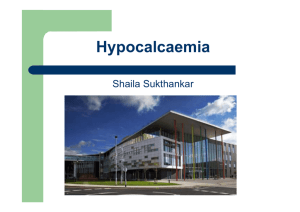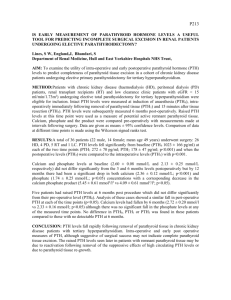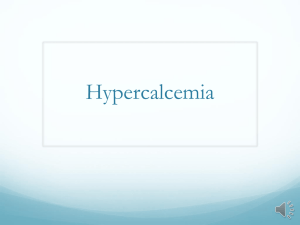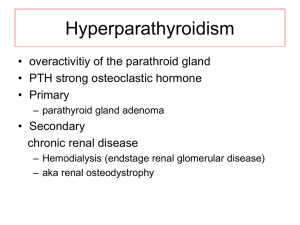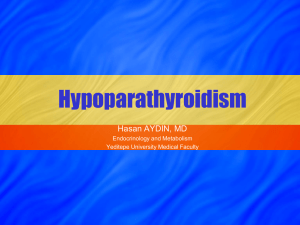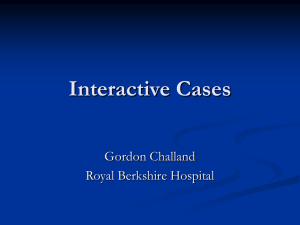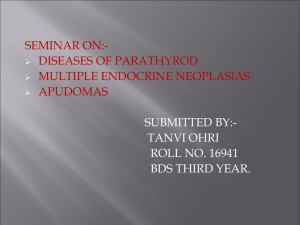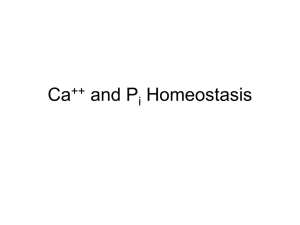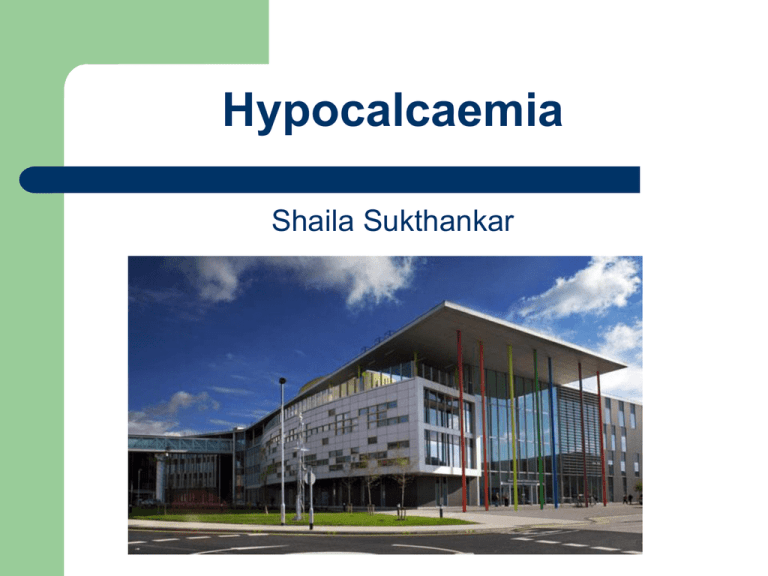
Hypocalcaemia
Shaila Sukthankar
Ca – Daily Requirements
Age/ sex
Ca (mg)
1-3
350
4-6
450
7-10
550
11-18 M
1000
11-18 F
800
19 +
700
Ca – Dietary Sources
(NDC)
Milk – 100 ml =120mg
Cheese – 15gm = 110mg
Yoghurt pot – 80gm = 160mg
Other sources
–
–
–
–
–
Fish
Meat
Bread
Cereal
Broccoli
Hypocalcaemia - Causes
Failure of secretion or actions of PTH
Disorders of vitamin D
CaSR disorders
Dietary Ca deficiency (CMPI)
Malabsorption of Ca – coeliac disease, short
gut, tufting enteropathy
Hypocalcaemia – Clinical Features
Neuromuscular excitability
Paraesthesia (tingling sensation) around mouth,
fingers and toes
Muscle cramps, carpopedal spasms
Tetany
Seizures – focal or generalised
Laryngospasm, stridor and apneas (neonates)
Cardiac rhythm disturbances (prolonged QT interval)
Chvostek’s and Trousseau’s signs – latent
hypocalcemia
Hypocalcaemia - Investigations
Ca and Pi
PTH
Vit D (25 hydroxy and 1,25 dihydroxy levels)
Mg
Urinary Ca/ Cr ratio
Hypocalcaemia - Approach
Low PTH
–
Normal/ low normal PTH
–
–
Hypoparathyroidism
Primary/ secondary
Mg deficiency
CaSR activating mutation
High PTH
–
–
–
Vit D deficiency
VDDR
Pseudohypoparathyroidism – types 1, 2
Treatment of Hypocalcaemia
Severe Symptomatic:
• IV 10% Calcium Gluconate @ 0.11 mmol/kg
(0.5 mls/kg – max 20 mls) over 10 minutes
• Continuous IV infusion of Calcium Gluconate
@ 0.1 mmol/kg (Max 8.8 mmols) over 24
hours
Severe Asymptomatic:
Oral Calcium Supplements @ 0.2 mmol/kg
(Max 10 mmols or 400 mg Ca) 4 x a day
Treatment of Hypoparathyroidism
• Aim to keep serum Ca between 2.0 to 2.2 mmol/l
• Oral Calcium supplements
• Active preparations of Vitamin D
•
• 1,25-dihydroxyvitamin D (Calcitriol)
• 1-α-hydroxyvitamin D (Alfacalcidiol) @ 50
nanograms/kg (Max ~2 micrograms/day)
Monitoring
• Urine Ca/Cr (<0.7)
• Renal Ultrasound Scan
Case 1 - Presentation
TM
8 years
Episodic palpitations, sweating and pallor
TIA at 4 years age
Referred to cardiology at RMCH – marginal
prolonged QTc
Incidental hypocalcaemia
Father has h/o kidney stones
Case 1 - Investigations
Ca 1.6 mmol/ l, Pi 2.6 mmol/ l, ALP 237
Vit D 23 ng/ ml
PTH 6 (normal 10 -70)
Urinary ca/ cr ratio 0.6 initially
Case 1 - Treatment
1 - alpha calcidol started initially at 0.5 mcg
daily
Ca/ Cr ratio rose to 0.9 – 1.2 when Ca levels
were 1.9 mmol/ l
Diagnosis – Activating mutation of the CaSR
CaSR
Present on the membrane of parathyroid
cells
Calciostat – regulates PTH sensitivity and
response to Ca levels in serum
Set at a “trigger” point to alter PTH secretion
as guided by Ca level
CaSR mutations and effect on PTH
Case 1 – Learning Points
In the face of hypocalcaemia, PTH value is
important
Urinary Ca/ Cr ratio monitoring is important
to detect hypercalciuria – particularly after
treatment is started
In the long term, over-treatment can lead to
nephrocalcinosis
Case 2 - Presentation
1 week old baby girl
Frequent short seizures at home for 2 days
Asian origin
Breast fed exclusively
Well in between seizure episodes
Apyrexial, no focus of infection
Mum had IDDM, on insulin (brief hypoglycaemia in
neonatal period)
Case 2 - Investigations
All inflammatory markers normal
U/E, blood gas and sugar normal
Head scan normal
Ca 1.6, Pi 2.7, ALP 400
PTH 15 (10 – 70)
Urinary ca/ cr ratio 0.4
Vit D 26
Mg 0.49
Case 2 - Treatment
Oral calcium supplements
Oral magnesium supplements
ABIDEC drops
Ca – Role of Mg
Always measure serum magnesium in a
hypocalcaemic child
Hypomagnesemia impairs PTH secretion
It also causes resistance to the actions of
PTH at the level of kidney and bone
Case 2 – Learning Points
Hypomagnesaemia may cause relative
insensitivity of parathyroid gland to
hypocalcaemia
Optimum treatment requires adequate
correction of low magnesium
Case 3 - Presentation
2 month old infant girl
Consanguinity, Somalian origin
Gastroenteritis
Breast fed
No seizures
No fever
Wide open AF and open PF
Case 3 - Investigations
Ca 1.6, Pi 1.8, ALP 650
PTH 434
Vit D 0.6 ng/ml
Mild metabolic acidosis
Case 3 - Treatment
Oral Ca supplements until serum Ca over 2.0
Cholecalciferol 3,000 Units daily for 6 weeks
ABIDEC advised for 6 – 12 months
Maternal assessment
After treatment with oral Calcium supplements and
vit D
–
–
–
–
PTH 400
Ca 2.0
Pi 0.4
25 OH vit D 55ng/ml
Case 3 – Learning Points
Increased awareness of vit D deficiency in breast fed
infants – especially of Asian and African origin
Routine/ opportunistic supplementation for breast fed
infants with MV drops
Maternal evaluation – likely vit D and iron deficiency
Sibling screening as indicated – for incidental vit D
deficiency/ rickets
When PTH persistently high after initial treatment,
check 1,25 dihydroxy levels too
An Approach to a Child Serum [Ca] <2.1 mmol/l
with
normal serum Albumin & Mg Concentrations
Urine
Ca/Cr
<0.56
mmol/mmol
>0.56
mmol/mmol
Serum P
Hypocalcaemic
hypercalciuria
Low
High
Vitamin D related causes
Serum 25 OH D
Normal
Low
Serum 1, 25
(OH)2 D
Low
VDDR
Type I
Serum PTH
Low
High
Vit D Deficiency
High
VDDR
Type II
Hypo-parathyroidism
Pseudo-hypopara-thyroidism
Picture quiz
Autoimmune Polyglandular Endocrinopathy
type 1
Mucocutaneous
candidosis
Alopecia
Brittle, dystrophic nails
Intestinal malabsorption
Autoimmune hepatitis
Keratoconjunctivitis
Asplenia
Parathyroid
Thyroid
Adrenals
Gonads
Pancreatic islet cells
Gastric parietal cells
Thank You!
Questions???

